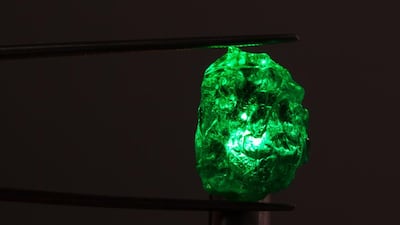An ethically sourced gem indicates that a particular stone hails from a mine where human and environment interests are safeguarded. With films such as Blood Diamond making buyers more aware of the horrific conditions behind "dirty" gemstones, to be able to tell whether a piece you own comes from a responsible mine is important to a growing number of jewellery lovers.
Now, a new and independent test developed by the Gübelin Gem Lab can confirm exactly where an emerald has been sourced from. The Emerald Paternity Test adopts a traceability technology to confirm the provenance of these rare and precious gems. Developed by gemstone analysts Gübelin Gem Lab, the test uses customised DNA-based nanoparticles to trace an emerald back to the exact place of its mining.
The nano technology is applied onto rough emerald crystals at the mine itself, and it can withstand the procedures the stones go through – cleaning, cutting, polishing, transportation and setting – before coming to the market. The particles can then be retrieved and analysed at any stage, offering corporate and government departments, jewellery brands and end users a means to ensure that they are buying a clean stone.
In order to bring more transparency into the coloured-gemstone industry, Gübelin also invited Gemfields to join the project as a test partner at Baselworld this month. A leading producer of responsibly sourced stones, Gemfields is the majority owner of the Kagem emerald mine in Zambia (the largest in the world), and the Montepuez ruby mine in Mozambique. Chief executive Ian Harebottle said: "Embracing innovation, technology and increased transparency is at the heart of our approach. We are excited about the outcome of this test as it offers a multitude of benefits to the industry and the buyer."
pmunyal@thenational.ae
Spec%20sheet
%3Cp%3E%3Cstrong%3EDisplay%3A%3C%2Fstrong%3E%204.7%22%20Retina%20HD%2C%201334%20x%20750%2C%20625%20nits%2C%201400%3A1%2C%20True%20Tone%2C%20P3%3Cbr%3E%3Cstrong%3EChip%3A%3C%2Fstrong%3E%20Apple%20A15%20Bionic%2C%206-core%20CPU%2C%204-core%20GPU%2C%2016-core%20Neural%20Engine%3Cbr%3E%3Cstrong%3ECamera%3A%3C%2Fstrong%3E%2012MP%2C%20f%2F1.8%2C%205x%20digital%20zoom%2C%20Smart%20HDR%2C%20Deep%20Fusion%3Cbr%3E%3Cstrong%3EVideo%3A%3C%2Fstrong%3E%204K%2B%40%2024%2F30%2F60fps%2C%20full%20HD%2B%40%2030%2F60fps%2C%20HD%2B%40%2030%20fps%3Cstrong%3E%3Cbr%3EFront%20camera%3A%20%3C%2Fstrong%3E7MP%2C%20f%2F2.2%2C%20Smart%20HDR%2C%20Deep%20Fusion%3B%20HD%20video%2B%40%2030fps%3Cbr%3E%3Cstrong%3EBattery%3A%3C%2Fstrong%3E%20Up%20to%2015%20hours%20video%2C%2050%20hours%20audio%3B%2050%25%20fast%20charge%20in%2030%20minutes%20with%2020W%20charger%3B%20wireless%20charging%3Cbr%3E%3Cstrong%3EBiometrics%3A%3C%2Fstrong%3E%20Touch%20ID%3Cbr%3E%3Cstrong%3EDurability%3A%3C%2Fstrong%3E%20IP67%2C%20dust%2C%20water%20resistant%20up%20to%201m%20for%2030%20minutes%3Cbr%3E%3Cstrong%3EPrice%3A%3C%2Fstrong%3E%20From%20Dh1%2C849%3C%2Fp%3E%0A
Company%20Profile
%3Cp%3E%3Cstrong%3ECompany%20name%3A%3C%2Fstrong%3E%20Cargoz%3Cbr%3E%3Cstrong%3EDate%20started%3A%3C%2Fstrong%3E%20January%202022%3Cbr%3E%3Cstrong%3EFounders%3A%3C%2Fstrong%3E%20Premlal%20Pullisserry%20and%20Lijo%20Antony%3Cbr%3E%3Cstrong%3EBased%3A%3C%2Fstrong%3E%20Dubai%3Cbr%3E%3Cstrong%3ENumber%20of%20staff%3A%3C%2Fstrong%3E%2030%3Cbr%3E%3Cstrong%3EInvestment%20stage%3A%3C%2Fstrong%3E%20Seed%3C%2Fp%3E%0A
The specs
Engine: 2.0-litre 4-cyl turbo
Power: 201hp at 5,200rpm
Torque: 320Nm at 1,750-4,000rpm
Transmission: 6-speed auto
Fuel consumption: 8.7L/100km
Price: Dh133,900
On sale: now
The%20specs
%3Cp%3E%3Cstrong%3EEngine%3A%3C%2Fstrong%3E%206.4-litre%20V8%0D%3Cbr%3E%3Cstrong%3ETransmission%3A%20%3C%2Fstrong%3E8-speed%20auto%0D%3Cbr%3E%3Cstrong%3EPower%3A%20%3C%2Fstrong%3E470bhp%0D%3Cbr%3E%3Cstrong%3ETorque%3A%20%3C%2Fstrong%3E637Nm%0D%3Cbr%3E%3Cstrong%3EPrice%3A%20%3C%2Fstrong%3EDh375%2C900%20(estimate)%0D%3Cbr%3E%3Cstrong%3EOn%20sale%3A%3C%2Fstrong%3E%20now%3C%2Fp%3E%0A
How to help
Send “thenational” to the following numbers or call the hotline on: 0502955999
2289 – Dh10
2252 – Dh 50
6025 – Dh20
6027 – Dh 100
6026 – Dh 200
Starring: Jamie Foxx, Angela Bassett, Tina Fey
Directed by: Pete Doctor
Rating: 4 stars
Ferrari 12Cilindri specs
Engine: naturally aspirated 6.5-liter V12
Power: 819hp
Torque: 678Nm at 7,250rpm
Price: From Dh1,700,000
Available: Now
UAE currency: the story behind the money in your pockets
A cheaper choice
Vanuatu: $130,000
Why on earth pick Vanuatu? Easy. The South Pacific country has no income tax, wealth tax, capital gains or inheritance tax. And in 2015, when it was hit by Cyclone Pam, it signed an agreement with the EU that gave it some serious passport power.
Cost: A minimum investment of $130,000 for a family of up to four, plus $25,000 in fees.
Criteria: Applicants must have a minimum net worth of $250,000. The process take six to eight weeks, after which the investor must travel to Vanuatu or Hong Kong to take the oath of allegiance. Citizenship and passport are normally provided on the same day.
Benefits: No tax, no restrictions on dual citizenship, no requirement to visit or reside to retain a passport. Visa-free access to 129 countries.
A meeting of young minds
The 3,494 entries for the 2019 Sharjah Children Biennial come from:
435 – UAE
2,000 – China
808 – United Kingdom
165 – Argentina
38 – Lebanon
16 – Saudi Arabia
16 – Bangladesh
6 – Ireland
3 – Egypt
3 – France
2 – Sudan
1 – Kuwait
1 – Australia
Structural%20weaknesses%20facing%20Israel%20economy
%3Cp%3E1.%20Labour%20productivity%20is%20lower%20than%20the%20average%20of%20the%20developed%20economies%2C%20particularly%20in%20the%20non-tradable%20industries.%3Cbr%3E2.%20The%20low%20level%20of%20basic%20skills%20among%20workers%20and%20the%20high%20level%20of%20inequality%20between%20those%20with%20various%20skills.%3Cbr%3E3.%20Low%20employment%20rates%2C%20particularly%20among%20Arab%20women%20and%20Ultra-Othodox%20Jewish%20men.%3Cbr%3E4.%20A%20lack%20of%20basic%20knowledge%20required%20for%20integration%20into%20the%20labour%20force%2C%20due%20to%20the%20lack%20of%20core%20curriculum%20studies%20in%20schools%20for%20Ultra-Othodox%20Jews.%3Cbr%3E5.%20A%20need%20to%20upgrade%20and%20expand%20physical%20infrastructure%2C%20particularly%20mass%20transit%20infrastructure.%3Cbr%3E6.%20The%20poverty%20rate%20at%20more%20than%20double%20the%20OECD%20average.%3Cbr%3E7.%20Population%20growth%20of%20about%202%20per%20cent%20per%20year%2C%20compared%20to%200.6%20per%20cent%20OECD%20average%20posing%20challenge%20for%20fiscal%20policy%20and%20underpinning%20pressure%20on%20education%2C%20health%20care%2C%20welfare%20housing%20and%20physical%20infrastructure%2C%20which%20will%20increase%20in%20the%20coming%20years.%3C%2Fp%3E%0A
The biog
Name: Abeer Al Shahi
Emirate: Sharjah – Khor Fakkan
Education: Master’s degree in special education, preparing for a PhD in philosophy.
Favourite activities: Bungee jumping
Favourite quote: “My people and I will not settle for anything less than first place” – Sheikh Mohammed bin Rashid.
The Sand Castle
Director: Matty Brown
Stars: Nadine Labaki, Ziad Bakri, Zain Al Rafeea, Riman Al Rafeea
Rating: 2.5/5
THE%20HOLDOVERS
%3Cp%3E%3Cstrong%3EDirector%3A%20%3C%2Fstrong%3EAlexander%20Payne%3C%2Fp%3E%0A%3Cp%3E%3Cstrong%3EStarring%3A%3C%2Fstrong%3E%20Paul%20Giamatti%2C%20Da'Vine%20Joy%20Randolph%2C%20Dominic%20Sessa%3C%2Fp%3E%0A%3Cp%3E%3Cstrong%3ERating%3A%3C%2Fstrong%3E%204.5%2F5%3C%2Fp%3E%0A
The Baghdad Clock
Shahad Al Rawi, Oneworld
Gertrude Bell's life in focus
A feature film
At one point, two feature films were in the works, but only German director Werner Herzog’s project starring Nicole Kidman would be made. While there were high hopes he would do a worthy job of directing the biopic, when Queen of the Desert arrived in 2015 it was a disappointment. Critics panned the film, in which Herzog largely glossed over Bell’s political work in favour of her ill-fated romances.
A documentary
A project that did do justice to Bell arrived the next year: Sabine Krayenbuhl and Zeva Oelbaum’s Letters from Baghdad: The Extraordinary Life and Times of Gertrude Bell. Drawing on more than 1,000 pieces of archival footage, 1,700 documents and 1,600 letters, the filmmakers painstakingly pieced together a compelling narrative that managed to convey both the depth of Bell’s experience and her tortured love life.
Books, letters and archives
Two biographies have been written about Bell, and both are worth reading: Georgina Howell’s 2006 book Queen of the Desert and Janet Wallach’s 1996 effort Desert Queen. Bell published several books documenting her travels and there are also several volumes of her letters, although they are hard to find in print. Original documents are housed at the Gertrude Bell Archive at the University of Newcastle, which has an online catalogue.
Tearful appearance
Chancellor Rachel Reeves set markets on edge as she appeared visibly distraught in parliament on Wednesday.
Legislative setbacks for the government have blown a new hole in the budgetary calculations at a time when the deficit is stubbornly large and the economy is struggling to grow.
She appeared with Keir Starmer on Thursday and the pair embraced, but he had failed to give her his backing as she cried a day earlier.
A spokesman said her upset demeanour was due to a personal matter.
GAC GS8 Specs
Engine: 2.0-litre 4cyl turbo
Power: 248hp at 5,200rpm
Torque: 400Nm at 1,750-4,000rpm
Transmission: 8-speed auto
Fuel consumption: 9.1L/100km
On sale: Now
Price: From Dh149,900


